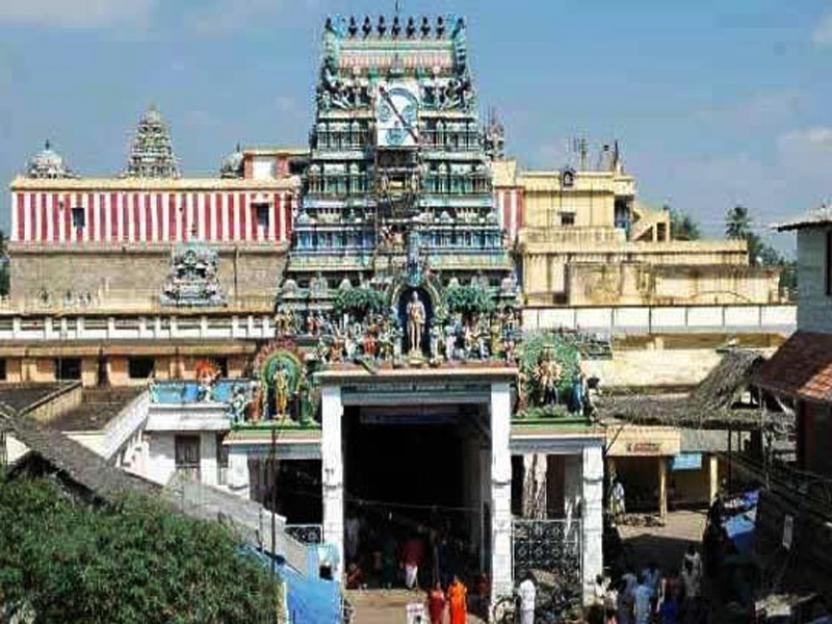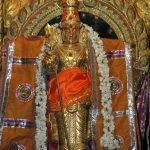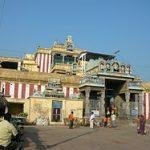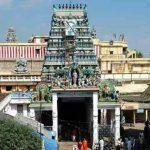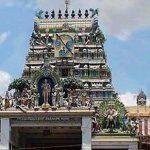Contents
Swaminathaswamy temple, Swamimalai, Thanjavur, Tamil Nadu
| Date built: | – |
|---|---|
| Deity: | – |
| Architectural style: | Dravidian architecture |
| Major festivals | – |
| Locale: | Swamimalai |
| District:: | Thanjavur |
| Address: | kumbeswaran thirumanjana veedhi, Swamimalai, Kumbakonam, Tamil Nadu 612302 |
| Phone | 04352454421 |
Swamimalai Swaminathaswamy Temple is a Hindu temple located in Swamimalai dedicated to Murugan 5 km from Kumbakonamon the banks of a tributary of river Cauvery, 250 km from Chennai, the capital of Tamil Nadu, India. The temple is one of the six holy shrines of Murugan called Arupadaiveedu. The shrine of the presiding deity, Swaminathaswamy is located atop a 60 ft (18 m) hillock and the shrine of his mother Meenakshi (Parvathi) and father Shiva (Sundareswarar) is located downhill. The temple has three gopuram (gateway towers), three precincts and sixty steps and each one is named after the sixty Tamil years. The temple has six daily rituals at various times from 5:30 a.m. to 9 p.m., and three yearly festivals on its calendar. The annual Vaikasi Visagam festival is attended by thousands of devotees from far and near.
As per Hindu legend, Muruga, the son of Shiva, extolled the meaning of the Pranava Mantra (AUM) to his father at this place and hence attained the name Swaminathaswamy. The temple is believed to be in existence from the Sangam period from 2nd century BC and was believed to have been modified by Parantaka Chola I. The temple was greatly damaged during the Anglo-French war between Hyder Ali and British in 1740. The temple, in modern times, is maintained and administered by the Hindu Religious and Endowment Board of the Government of Tamil Nadu.
Architecture
In Swamimalai, Muruga is known as “Balamurugan” and “Swaminatha Swami”. The temple is built on an artificial hill. In Tamil language, such an artificial hill is called “Kattu Malai”. Another name for this place is “Thiruveragam”. The temple has three gopuram(gateway towers) and three precincts. Out of the three precincts, one is located in the basement, the second at midway to the top of the hillock and the third on the hillock, around the sanctum of the Swaminathaswamy shrine. There are sixty steps and each one is named after the sixty Tamil years. The first thirty steps lead to the second precinct of the temple. The image of Swaminathaswamy is 6 ft (1.8 m) tall. There are golden armours, golden crowns and a diamond lance for Swaminathaswamy. There is a shrine of Vinayagar outside the first precinct. The central shrine houses the granite image of Swaminathaswamy. The first precinct has the images of Dakshinamurthy, Durga, Chandikeswarar and the festival image of Swaminathaswamy. The images of Sundaresawar as lingam (Shiva) and Meenakshi (Parvathi) are located down hill and the first precinct around their shrines have the images of Dakshinamurthy, Durga, Chandikeswarar and Navagrahas. The second precinct and the largest one of the temple houses a marriage hall and the chariot of the temple.The temple is one of the most visited temples in the district. The original animal mount of Murugan is believed to have been an elephant, compared to the peacock which is considered to be the most common mount. The white elephant, is considered a powerful, terror striking animal. The iconography is maintained only in two places, namely, this temple and Tiruttani Murugan Temple.Unlike other Murugan temples, where peacock is sported axial to the image of the presiding deity, an elephant is seen in front of Murugan in the temple.
Legend / Local stories
As per Hindu legend, Brahma, the Hindu god of creation, disrespected Muruga (the son of Shiva) at the time of visiting Mount Kailash, the abode of Shiva. The child Muruga got angry with Brahma and asked him how he was creating living beings. Brahma said that he was creating living beings with the help of the Vedas (Hindu scriptures). On hearing the reply, Muruga asked Brahma to recite the texts from Vedas. Brahma started to recite the text with the holy word called Pranav Mantra, “Om”. At that time Muruga stopped Brahma and asked him to explain the meaning of the Pranava Mantra. Brahma did not expect such a question from the child and could not reply.Muruga knocked Brahma on his forehead with his clenched fists and punished him with imprisonment. Muruga took up the role of the creator. The Devas (celestial deities) were surprised by the absence of Brahma and they requested Vishnu to negotiate with Muruga to release Brahma. Vishnu could not help and as the last resort, Shiva went to the rescue of Brahma.
Shiva came to Muruga and asked him to release Brahma from imprisonment. Muruga refused to release him stating Brahma was unaware of the meaning of the Om – Shiva asked Muruga to explain the meaning and Muruga extolled to Shiva the meaning of Om. Shiva behaved like a student to a teacher, listening with rapt attention from his son, giving Muruga the name “Swaminatha Swami”.The meaning of this name is “The Teacher of Shiva”.Following the legend, the shrine of the son Muruga is atop the hillock, while the father Shiva’s shrine is located at the basement.
As per another legend, once all sages and gods assembled in Kailash, the abode of Shiva. It resulted in the tilting of earth towards one direction. Shiva asked sage Agasthya to move towards South to balance the tilt. Agastya employed a demon by name Ettumba to carry two hills in his shoulders to be placed in the South. The demon carried the hills down south and rested in a place. When he tried to lift one of the hills, it didn’t budge and he found a young man standing at the top of the hill not allowing it to be moved. The demon tried to attack the young man, but was smitten. Sage Agastya identified the young man as Karthikeya and asked him to pardon the demon. Karthikeya readily did so and let the hill remain there at Pazhani. It is a practice followed in the modern times where people carry milk in both their shoulders as a devotion to please Karthikeya. The demon carried the other hill to Swamimalai.
Photo Gallery
How to Reach:
Contact Details
Official Address

